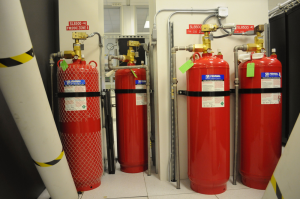A commonly asked question in the fire protection world is the difference between fire sprinkler and fire suppression systems. Many people do not realize that fire sprinklers and fire suppression systems have major differences and are used in varying applications.
Overall, fire sprinklers and fire suppression systems have a common purpose: to extinguish a fire as quickly as possible while minimizing damage to property and saving lives. The differences in the two systems are found in the ways each achieves its goal.
Fire Sprinkler Systems
A sprinkler system uses water as an agent for extinguishing a fire. Fire sprinklers are one of the most common forms of fire protection and are very effective at putting out fires. A fire sprinkler is activated when heat or smoke is detected and it will then discharge water to extinguish a fire in the affected area.
Types of Sprinklers
There are many types of fire sprinklers including:
- Wet Pipe Sprinklers
- Dry Pipe Sprinklers
- Pre-Action Systems
- Deluge Sprinklers
Benefits & Disadvantages
Fire sprinklers are the most popular form of fire protection for a reason. They very effective at extinguishing fires and can be an affordable fire protection solution. Sprinklers are versatile and well-suited for a variety of applications.
Although fire sprinklers are the most commonly utilized form of fire protection, there are some instances where fire sprinklers will not be effective in putting out a fire or where they will cause irreparable damage to property. In these situations, a fire suppression system is installed.
Fire Suppression Systems
Fire suppression systems are similar to fire sprinkler systems except they do not use water to put out a fire. Instead, fire suppression systems often use chemical, gaseous, or foam agents to extinguish a fire.
Benefits of Fire Suppression
Fire suppression systems are used in environments where valuable equipment and unique assets (museums, art galleries, archives, etc.) are present. These systems respond
 rapidly and will extinguish a fire while causing minimal damage to valuable assets. Suppression systems are also used in high hazard applications, such as facilities that contain flammable liquids or combustible materials, because they can provide the level of protection needed to prevent disastrous fires.
rapidly and will extinguish a fire while causing minimal damage to valuable assets. Suppression systems are also used in high hazard applications, such as facilities that contain flammable liquids or combustible materials, because they can provide the level of protection needed to prevent disastrous fires.
Types of Suppression Systems
The different types of fire suppression systems include:
- FM200 Suppression
- CO2 Suppression
- Wet Chemical Systems
- Dry Chemical Systems
Each suppression system is designed based on the special hazards that need to be protected.
Choosing the Right Protection
When deciding which type of system is right for your building, you must consider what you are trying to protect and the different fire hazards present. Your building code may specify what type of system you will need. If you are looking to install fire protection in a new building or retrofit a system into an existing building, you can contact a local fire protection professional to figure out which type of system is right for your facility.